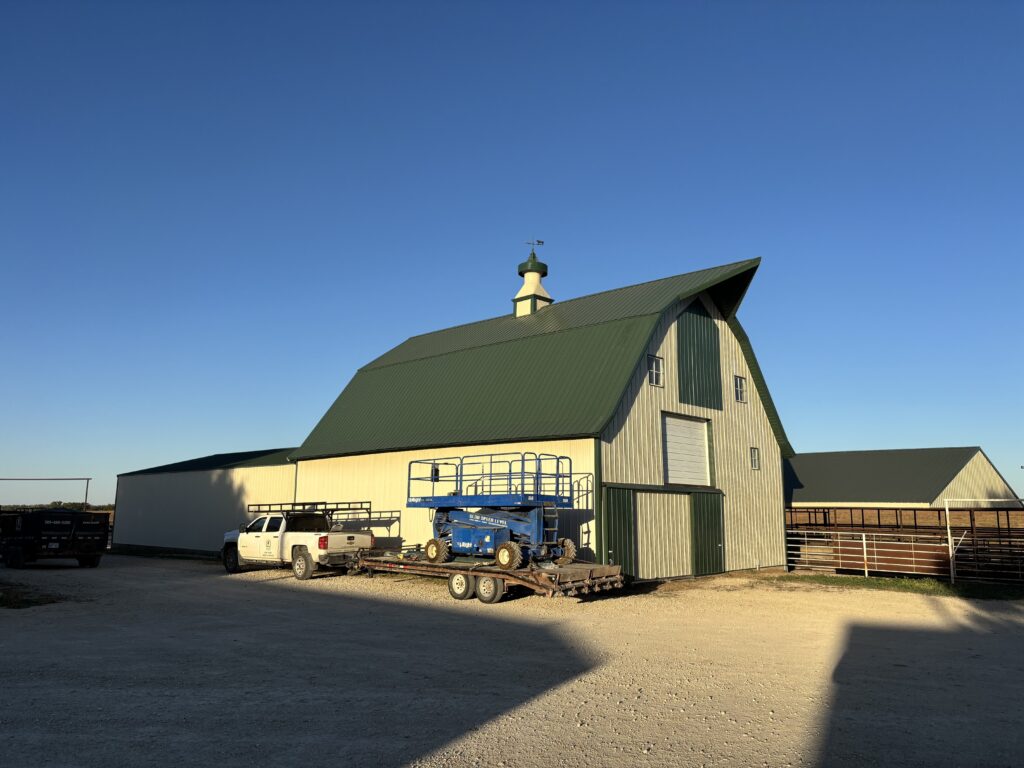When planning a post-frame building in Kansas, one of the most important design choices is the roof slope, or “pitch.” The roof slope affects how a structure handles wind, snow, and rain, as well as how it looks and performs over time.
Kansas weather changes fast — heavy wind one week, snow and heat the next — so choosing the right slope helps a building stay durable and low-maintenance for decades.
What Roof Slope Means
Roof slope (also called pitch) measures how steep the roof is. It’s expressed as the rise over run, meaning how many inches the roof rises vertically for every 12 inches it runs horizontally.
A 4:12 slope, for example, rises four inches for every foot of horizontal length.
In post-frame construction, most roofs range between 3:12 and 6:12, depending on design goals, materials, and local weather conditions.
How Weather Impacts Roof Slope in Kansas
Kansas sits in the middle of the Great Plains, where the combination of snow, wind, and summer heat makes roof performance a serious design factor.
- Snow and Rain Drainage – Steeper slopes shed water and snow faster, reducing the chance of pooling, leaks, or ice buildup.
- Wind Load – Flatter roofs experience less uplift pressure, but they require stronger framing and fastening systems to resist storms.
- Heat and Ventilation – A steeper roof often improves airflow and attic ventilation, which helps prevent heat buildup and condensation during humid Kansas summers.
Choosing the right slope means balancing these environmental factors with the building’s intended use and structure type.
Slope Options and Their Trade-Offs
Each slope range offers specific advantages and challenges:
- Low Slope (3:12 or less)
- Easier to install and often uses fewer materials.
- Less visible from the ground, giving a simpler look.
- Slower water runoff, so details like underlayment and flashing become critical.
- Medium Slope (4:12 to 5:12)
- Common for Kansas post-frame shops and garages.
- Provides efficient water runoff without major increases in material cost.
- Offers a balanced look that fits both agricultural and residential designs.
- Steep Slope (6:12 or more)
- Visually striking and adds interior headroom for lofts or attic storage.
- Encourages faster runoff and better ventilation.
- Involves more material and labor, increasing build complexity.
Design Considerations Beyond Weather
A roof’s slope also influences how the building functions inside. Taller slopes allow for overhead storage or vaulted ceilings, while lower slopes reduce heating volume and simplify maintenance.
Exterior finishes can also look different depending on the pitch — for example, metal roofing panels may appear flatter on a 3:12 roof but create more depth and shadow on a 6:12.
Examples from the Field
In central and northeast Kansas, most post-frame shops and barns use a 4:12 to 5:12 roof slope. This range performs well in wind, sheds snow efficiently, and still maintains a clean, traditional appearance.
In areas with heavier snow or more design-driven projects like barndominiums, slopes of 5:12 to 6:12 are more common to improve drainage and roof strength.
Practical Questions to Answer Before Deciding
Before finalizing a design, builders and owners should discuss:
- What the building will be used for — storage, livestock, living space, or a mix.
- How exposed the site is to wind or runoff.
- Desired ceiling height and ventilation needs.
- Roofing materials being used and their slope requirements.
- Any local building code or neighborhood design restrictions.
Each of these details influences the roof structure, framing, and materials needed to perform well over time.
Summary
Selecting the correct roof slope in Kansas is about more than looks — it’s a structural decision that affects performance, safety, and longevity.
A well-designed slope manages water, wind, and heat effectively, reducing maintenance and extending the life of the building.
Understanding how slope, structure, and environment work together helps ensure every post-frame project stands strong through Kansas seasons.




